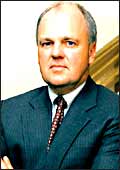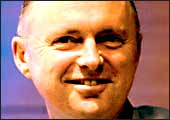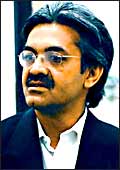|
Whose
win is it anyway? Soon after the Company Law Board (CLB) gave
its verdict on the Haldia Petrochemical (HPL) case on January
31 (after a hearing that lasted for more than a year), directing
the West Bengal government to sell its entire stake to joint venture
partner Purnendu Chatterjee, many thought it was Chatterjee's
victory over the state. The state thought it that way too. But
24 hours later it did a flip-flop, harping on the particular part
of the CLB verdict which upheld the West Bengal government's allotment
of 150 million of HPL shares to Indian Oil Corporation (IOC) for
Rs 150 crore. The Chatterjee group obviously isn't celebrating
any more, having found reason to be unhappy with the CLB offer.
Result? The imbroglio over HPL's management control seems to be
far from over even after the CLB order. Both Chatterjee's TCG
group and the state are keeping open further legal options.
"An amicable solution is still possible, if the state so
desires. We'll try not to do something that may antagonise the
state," says a close aide of Chatterjee, trying to hide their
disappointment over the CLB order. Nirupam Sen, West Bengal Commerce
and Industries minister, adds: "We are not averse to selling
out our entire stakes in HPL to TCG, provided they take it at
one go and make upfront payment. But we are considering all legal
opinions and not ruling out moving the Calcutta High Court, challenging
the CLB order either." In the present scheme of things, the
Chatterjee group has a 59.9 per cent stake in HPL, the state has
36.88 per cent and Tatas 3.2 per cent. However, if the state's
stake sale to IOC is taken into account (which the quasi-judicial
body has already upheld), then the equity structure on expanded
capital would be TCG: 54 per cent, West Bengal Industrial Development
Corp: 33 per cent, Tatas: 2.8 per cent and IOC: 9.6 per cent.
Another sour point is the CLB's directive that the price payable
for the 520 million shares should be the fair price determined
by the valuer appointed by it or Rs 28.80, whichever is higher.
TCG has been demanding appointment of an independent valuer as
per the original joint venture agreement. The stalemate continues.
-Ritwik Mukherjee
Can
You Spot The CFO?
Most media finance heads are obscured by
their bosses.
 |
| E&Y’s Nendick: Spotlight on
CFOs |
For over
10 years, Ronald D'Mello was the Director-Operations and Finance
(equivalent of a CFO) of media and entertainment major UTV Software
Communications. In 2006, he moved up as Chief Operating Officer,
and is today at the forefront of the company's growth strategy.
"The media business is tough. Creativity alone does not make
sense. Making money is equally important," quips the 42-year-old
D'Mello.
D'Mello may be a rare example of a CFO in the Indian media &
entertainment (M&E) sector moving up to the top operational
position, but his elevation does highlight the increasingly important
role of the Finance Chief in M&E companies. A recent global
M&E survey by Big Four consultants Ernst & Young, dubbed
Centre Stage: CFOs and Finance Executives in the Spotlight of
an Industry in Transition, concludes: "In the current global
environment no one has a more pivotal role than the cfos and other
finance executives, who must execute a command performance everyday
before a demanding global audience and all other stakeholders."
The survey was conducted among more than 200 global finance executives,
46 of them CFOs and six of them from India. The survey highlights
the larger role of the CFO, who has moved beyond the plain-vanilla
finance function to assist the CEO in strategic decision-making,
including scenario analysis, customer product analysis and investment
optimisation. As John Nendick, Global Head (Media & Entertainment
Practice), Ernst & Young, explains: "Rapid changes in
the M&E industry have made it more complex and unpredictable.
Along with several opportunities, there are risks as well that
need to be considered. This makes the CFO's function critical,
as he has to derive more value from existing investments and operations."
However, CFOs of Indian M&E companies may have still not
made this crucial transition. "After speaking to the Indian
CFOs of media companies we find that CFOs are still involved largely
with budgeting and related activities. They are still not involved
in the strategy of the company overall. It will be at least three
years before Indian CFOs of media companies take centre stage,"
says Farokh Balsara, Head (Media and entertainment practice) at
E&Y in India. That probably explains why only six Indian CFOs
from the media companies participated in the global survey. Most
CFOs who were contacted were not available. Clearly, the promoter's
towering shadow looms large over most Indian CFOs.
-Anusha Subramanian
Holding
No Ace(r)s?
Taiwanese major needs some wildcards
in India.
 |
| Acerís Rajendran (left) and Intelís Nair:
Power duo |
India
has been a difficult market to crack for the $11.31 billion (Rs
50,895 crore) Taiwanese electronics giant Acer, which is struggling
against entrenched competitors such as hp, Lenovo and HCL in the
desktop and notebook segments. The company has just 3.6 per cent
of the desktop market compared to over 30 per cent for both hp
and HCL Infosystems. Even in notebooks, where it doubled its market
share a couple of years ago, Acer slid backwards recently in the
face of a strong onslaught from rivals, most noticeably from hp
which signed on Bollywood star Shah Rukh Khan to promote its products.
While saturated developed markets (especially in the us and Japan)
compelled Acer to shift its desktop focus to rapidly growing geographies
such as China and India (where, according to MAIT, the hardware
industry body, pc sales for the first-half of this year grew almost
20 per cent to 2.96 million units), there has thus far been little
indication that its switch in strategy has been successful.
"We have an almost invisible presence in the desktop market,"
admits S. Rajendran, General Manager (Sales and Marketing) at
Acer India, who adds that the company is now witnessing strong
growth in two key segments, education and e-governance, and expects
an upturn in its fortunes imminently. In addition, Acer has also
tried to create a new market niche with its Ultra Small Form Factor
pc tower, which is a tenth of the size of a conventional 30-litre
CPU and consumes one-third of the power conventionally used-all
this without any compromise on power (with an Intel Core 2 Duo
processor under the hood). It's also competitively priced between
Rs 39,999 and Rs 49,999. "In the Indian market, desktops
account for around 85 per cent of the market and we want to grow
our presence in this market aggressively," says Rajendran.
Acer's problem is that while it looks to go toe-to-toe with its
much larger rivals in the Indian market, it has more immediate
problems in the form of Zenith and Lenovo snapping at its heels.
"We believe we offer customers a good mix of price and value
and we have been able to grow our market share as a result,"
says Devita Saraf, ED, Zenith Computers.
To shore up its presence in India, Acer has overhauled its sales
and marketing set-up, by giving its field staff more responsibility
(and more accountability) than earlier. "We used to have
individual sales reps for desktops and notebooks, but we've now
moved to a model where we give them overall responsibility for
a group of re-sellers in a specific location," says Rajendran.
Acer's other issue is to get an uncluttered space in a crowded
retail market, which aside from mainline vendors such as hp and
Acer, also makes space for a raft of smaller brands and unbranded
players. "We sell our products through 2,500 re-sellers and
106 exclusive outlets, but we are constantly fighting the clutter
on the retail front," says Rajendran. With pc vendors throwing
up launches every 30-45 days and HP and Dell expected to step
on the gas in the next few months, the pressure is unlikely to
ease on Acer anytime soon.
-Rahul Sachitanand
Faster,
Higher, Stronger
Internet usage is driving the development
of faster processors.
 |
| Intel’s Maloney: Genius inside |
Bump into
Sean Maloney, and he's likely to yank out Intel's latest 'Core
2 Duo Extreme' quad-core processor and ask you: "Did you
think five years ago you would have needed that much computing
power?" Before you finish shaking your head, the Executive
Vice President & Global Head of Sales & Marketing at Intel
will explain what's driving the development of faster processors.
"People are spending more and more time online, and without
the internet the personal computer is actually quite useless.
Online video is already a big thing and the next big thing will
be real-time delivery of video. From anybody, anywhere and from
virtually any device." And this brings Maloney to one of
his favourite topics: Mobile broadband. Maloney, who is being
touted by some as the next potential Chief Executive of the world's
leading processor maker, played a key role in the development
of the IEEE 802.16 standard, or WiMax as Intel calls it. Recently,
Intel started a pilot WiMax project in Baramati in Maharashtra
(Business Today, December 17, 2006) and Maloney believes that
governments across the world have to take spectrum issues more
seriously. "Information is like water, and from a pure capacity
point of view, mobile radio broadband through standards such as
WiMax will be the driver to get more people, especially in countries
like India, access to that information." And this Maloney
says is what's driving the development of new processors from
Intel, especially for laptops. "We are already working on
the second-generation of WiMax standards called 802.16e, and our
hope is to integrate the 802.16 and 802.11 (Wi-Fi) standards onto
one processor."
-Kushan Mitra
Tapping
Peter to Pay Paul?
PE may help the Ramoji Group repay
depositors.
 |
| Ramoji Group’s Rao: Blackstone
to the rescue |
It's not
often that a business group that's accused of financial jugglery
gets a generous dose of private equity (PE). But then again the
Ramoji Group, which owns Eenadu, Andhra Pradesh's largest circulated
Telugu daily, television channel ETV and Ramoji Film City (the
group also has interests in foods, hospitality and financial services),
isn't your regular business conglomerate. Ramoji Rao, a key promoter
of the group, is seen to be a supporter of the Telugu Desam party
and, by virtue of that, an obvious baiter of the Congress, which
is in power in the state. His newspaper and TV channels regularly
go to town with stories on alleged wrongdoings of Congress partymen.
The Congress, for its part, never misses an opportunity to hit
back-just as it did recently when one of the party's mp V. Arun
Kumar raised questions about the manner in which Rao raised and
held funds in Margadarsi Financiers-a Hindu Undivided Family Trust.
The allegation is that the funds got invested in loss-making group
entities. Arun Kumar felt it was time the group came clean on
the solvency of its companies as that would help restore confidence
of the depositors of Margadarsi Financiers. The state government
has set up two official inquiries: One, to investigate the alleged
financial irregularities of Margadarsi Financiers; and the other
authorises an Inspector General of Police in the cid to gather
details and to file applications in relevant courts to take appropriate
action against Ramoji. The man has responded by duly moving the
Andhra Pradesh High Court, challenging the authority of both the
actions.
And of course his media channels-both print and television-are
serving as perfect platforms from which to deny the allegations
and attempt to reassure investors that the group has the capacity
to repay them.
Perhaps these investors would have received a confidence booster
last fortnight when PE major Blackstone said it would take a stake
in Ushodaya Enterprises (UEL), the Ramoji group entity that controls
Rao's media firms. As per the deal, said to be one of the largest
single investments in Indian media by a global PE player, Blackstone
is expected to acquire over 20 per cent stake in UEL and have
representation on its board. UEL expects to raise $465 million
(Rs 2,093 crore), which comprises Blackstone's investment of $275
million (Rs 1,238 crore) and $190 million (Rs 855 crore) of bank
financing. No further terms of the deals have been disclosed.
The transaction is subject to regulatory approval of the Foreign
Investment Promotion Board and the Ministry of Information and
Broadcasting.
For the year ended March 31, 2006, UEL posted a net profit of
Rs 56.8 crore on a turnover of Rs 752.16 crore. A Ramoji group
official explains that the funds have been raised for consolidation,
restructuring and growth of the media businesses. He adds that
the investment will help strengthen the group and unlock the promoters'
investments, which could be used to repay depositors in Margadarsi
Financiers. In an official statement, Akhil Gupta, Chairman &
Managing Director, Blackstone Advisors India, says: "We believe
that UEL is an ideal platform for Blackstone to play this highly
attractive sector in India. We have been very impressed by UEL's
management team and feel privileged that Rao has chosen Blackstone
to be the company's partner as UEL enters this very important
next phase of its growth." It's over now to the Congress.
-E. Kumar Sharma
Fuelled
by Focus
With a bouquet of services, Starcom
hits pay dirt.
 |
| SMG’s Ravi Kiran |
When Ravi
Kiran says "no media network in India offers as complete
a solution to its clients as we do," you would be tempted
to dismiss it as yet another adman's exaggerated claim. But the
diminutive CEO of Starcom MediaVest Group (SMG) in India may actually
not be guilty of overstating his agency's bouquet of services.
"We realised early on (Starcom was born in 2000) that TV
and print cannot be the only media that clients can look at in
the long run. Our new game therefore was to take an inclusive
view of media and develop specialised skill-sets aggressively.
That is how we started setting up new and non-classical units.
Our business structure is based on discipline, geography and sectors."
Discipline involves focussing on specialist business units such
as digital and entertainment, with Starcom Digital & Entertainment,
out-of-home advertising with Enhance and sports with Relay. Taking
care of the geography bit is Expanse, which is focussed on small
towns and rural markets, whilst sectors mean that Starcom will
set up separate agencies for specific high-growth industries,
or even for a single client operating in such sectors. For instance,
recently Starcom and Kishore Biyani's Future group jointly set
up FutureWorks, which will manage the media needs of all companies
and brands belonging to the Future group. The size of the account
is estimated at Rs 200 crore annually. In the US, Starcom has
a similar arrangement with General Motors; it has a separate agency
called gm Planworks, which exclusively manages the auto giant's
$3.6 billion (Rs 16,200 crore) account, with six offices and over
500 people. More recently, Ravi Kiran announced the launch of
'C', the first Indian agency to cater exclusively to the lifestyle
sector.
But it's not all about just specialist services. Starcom has
also developed and inherited some proprietary tools. For instance,
the agency strengthened its TV planning and buying last year by
introducing TARDIS, SMG's globally renowned TV tool, which incorporates
the world's smartest and post powerful TV optimiser. TARDIS, say
Starcom officials, can save clients anything between 5 and 25
per cent in planning costs alone on their TV budgets, even as
TV plans get dramatically superior. In 2005, Starcom also implemented
a high-end transaction management system called StarScape, which
allows smooth handling of large Agency of Record accounts.
Starcom is now working towards coming up with new divisions
in the areas of Diaspora Marketing and Word of Mouth. Ravi Kiran
says diaspora marketing will begin sometime during 2007 and that
this unit will be based in Mumbai and help brands communicate
with South Asians across the world. It will deal with 11 markets
where 80 per cent of the non-resident Indian population lives.
With such specialist skills, it isn't surprising that Starcom
says it's been growing in excess of 40 per cent over the past
three years. Which is probably why Ravi Kiran can afford to be
choosy when selecting clients. Currently the agency has a basket
of 40 clients. "We believe we have a responsibility to keep
up the servicing levels to clients and also allow our people the
freedom and time to grow... Mindless pitching is a recipe for
disaster. We have fairly well defined criteria on the basis of
which we choose clients. In fact, many of our clients that we
service today have given us business without a pitch. We are also
clear that we want only those clients who have a forward view
of consumers, brands and media," adds Ravi Kiran. And you
thought they didn't exist!
-Anusha Subramanian
Banking
at the Back End
Now, agri-retailers eye the microfinance
route.
 |
| Ramping up retail: New finance route |
In a bid
to shore up supply side linkages for their agri-retail businesses,
in the rural and semi-urban markets, conglomerates like Reliance,
Bharti-Wal-Mart, Pantaloon Retail and Subhiksha are all set to
turn financiers. If media reports are to be believed, some like
Reliance Industries (RIL) have already approached the Reserve
Bank of India (RBI) for permission to institute Non-Banking Financial
Companies (NBFCs), which would tap the microfinance route. RIL
officials had no comment to offer on the matter.
While the companies themselves are circumspect about divulging
their plans, reliable industry sources indicate that, to begin
with, the total scale of operations would be a modest Rs 7,000-10,000
crore. Nonetheless analysts are bullish on the possibilities it
may hold for the microfinance sector, which currently services
no more than 8 million households and 70 per cent of whose operations
are concentrated in the four southern states. "The only way
companies can control supply chain dynamics is through the finance
route," says Gokul Patnaik, Chairman, Global AgriSystems,
"this therefore is a good strategic move." Adds Damodar
Mal, President (Foods), Pantaloon Retail: "This is a lucrative
space considering the scale of the operations involved and also
because there are no real entry barriers."
But not everyone is convinced. Says Achla Savyasachi, Associate
VP, Sa-Dhan, a Delhi-based representative body of microfinance
institutions (MFIs): "Large companies have enormous overhead
costs, which will be passed on to the customer. Moreover, these
companies do not fully understand the dynamics of the microfinance
space." In fact, industry is already rife with speculation
on whether the biggies will go it alone or will partner or acquire
existing MFIs. "We have to contend with issues related to
creditworthiness and default on payments," admits a Bharti
insider, "this will make it imperative to partner existing
players in the MFI space." Cautions Kalyan Chakravarthy,
Country Head, Food & Agri-Business, yes Bank: "Retailers
would need to check the quality of MFIs they are partnering with
or taking over. The business model has to be parameterised, one
that adopts a participatory approach, as issues of ownership and
security are interrelated in the microfinance space."
-Aman Malik
Harmonic
Change
Saregama beefs up on the creative
and technical fronts.
 |
| RPG’s Chattopadhyay: New music |
When RPG
group company Saregama hurtled into the red in 2003-04, Vice Chairman
Sanjiv Goenka took a decision to de-risk the company's business
model by diversifying away from the fickle business of Hindi music.
The company has since turned around, and forays into home videos,
online music distribution and film production have helped the
105-year-old company spread its risks. Now, however, Saregama
is seeking to spread its wings within the music segment itself.
Explains Subroto Chattopadhyay, President & CEO, Management
Board Member, RPG Enterprises (Entertainment Sector): "It
was decided that we would look at six verticals: Creation and
exploitation of music in every single format, the creation of
television content, films, radio content, events, and the sixth
being the network business-as in, how do we get across to the
consumer."
One way Chattopadhyay plans to exploit music is to go back to
the languages and focus on regional markets-Bhangra for Punjab
(and also London), Bangla for Kolkata, Telugu for Hyderabad and
so on. Another way to do it is via the audio-visual medium. As
Chattopadhyay puts it: "What we have done is embedded within
the system people who understand the subject. That is the reason
why for Hindi content we have people like B.R. Sharan, an advertising
veteran, Vijay Laxmi, a veteran of radio and renowned film maker
Aparna who bring creative and technical know-how on board."
He also points out that with the introduction of these people,
the capabilities of the company have taken a jump-shift. "We
will support them, build little organisations around them, and
then allow them to build their own eco-system." Adds Sharan,
Chief Creative Officer, RPG Enterprises (Entertainment Sector):
"What I hope to bring to the table really is the experience
of advertising, to focus certain types of movies towards certain
types of consumers."
-Deepti Khanna Bose
|











